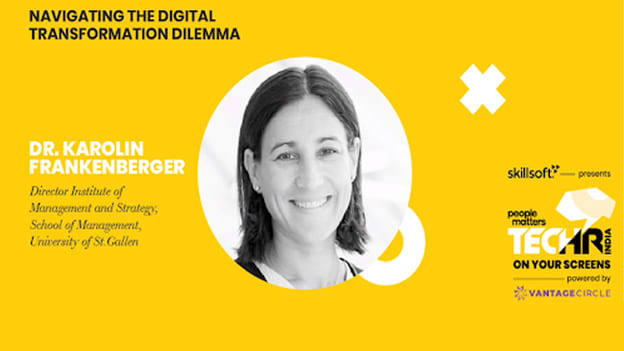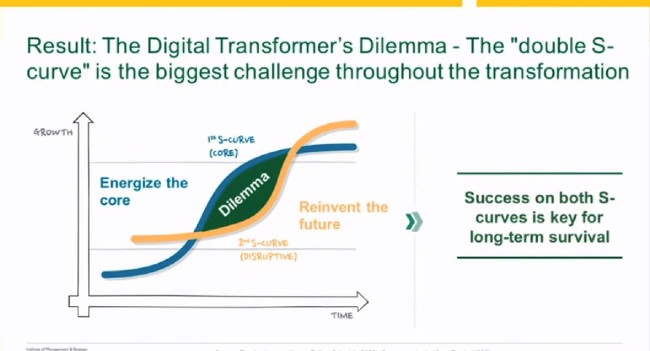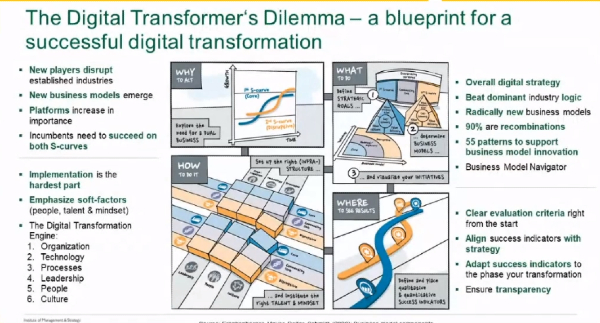The dilemma of digital transformation

Digitization is pervasive and requires businesses to adapt fundamentally. Organizations need to upgrade their traditional business while exploring new digital ways of value creation and capture. Companies need to transform else they will die, for sure. And the need to act is based on multiple factors. New players emerge and disrupt established industries and we see new business models emerge. So, incremental change of the core business alone will no longer suffice, instead, we need a fundamental transformation of the core business to gain a competitive edge.
However, the transformation of a business is challenging and according to McKinsey, more than 70 percent of transformation initiatives fail. “Two years of research including interviews with CEOs and CDOs around the globe reveals the digital transformer’s dilemma. It’s is the double S-curve which is the biggest challenge throughout the transformation,” says Dr. Karolin Frankenberger, Director Institute of Management and Strategy, School of Management, University of St.Gallen in a session at TechHR India 2020.

The blue line is the core business model and the orange curve is the new business model. What is important here is that you need to master both the curves to be able to survive in the long term. What does this mean? On your core business model, you need to have strong leadership control to manage your core business while you also need to imbibe entrepreneurial leadership which is about coming up with new ideas.
There are six categories you need to focus on to be able to succeed in transforming your business, says Dr. Karolin. It includes soft factors such as leadership, people and culture, and hard factors such as organization, culture, and processes. The soft factors are about instituting the right talent and mindset and the hard factors are about setting the right infrastructure. Dr. Karolin cites the quote of Ian Roberts, the CTO of Buhler, which says, “leadership, people, and culture really are the most crucial to tackle. They are more important than anything else. The rest is just process”. So the role of HR and talent managers is more important today than ever in terms of instilling the right culture and hiring the right people.
The dilemma between the two S-curves
How do you reconcile the two vastly different schools of thought in one firm? How do you avoid the negative overtone of an old school and new school dichotomy? And finally, how do you ensure functioning knowledge exchange between both S-curves? What is important to understand here is that you need to balance between leading the core –transactional leader, and leading the new –the transformational leader. In terms of anxiety and fear associated with transformation, Dr. Karolin cites the example of a company called Daimler. The company was struggling to transform because they were accustomed to the traditional way of working. The company then checked the agility and openness quotient of their leaders. They came out with a rating that made it transparent about their positioning. They realized that the leaders are ready to change but there is a fear factor.
Leadership traits required for digital transformation
The leaders need to lead authentically on both S-curves. It’s important for them to inspire and empower employees while welcoming intelligent failures. Leaders also need to be pragmatic and trust in the power of networks. Finally, they need to demonstrate emotional intelligence, lead by example, and show adaptability. Without these traits, leaders today cannot transform their business. It’s important for them to hire people who don’t say, “I am only interested in the type of innovation that worked in the past”. You need to look for key people attributes such as courage, self-starter, and key functional skillset. You need people who have the courage to come up with new ideas and experiment with them. Developing people with the right skills and attitudes is crucial for success.

To solve the people dilemma, leaders also need to follow best practices. Look for talent with the courage to face the challenges posed by digital transformation. To do this, you need to calibrate a mix of retraining, recruiting, renting, and reconfiguring to source your digital talent. Finally, your organizational design defines bridging the gap between 1st and 2nd S-curve employees, adds Dr. Karolin.













